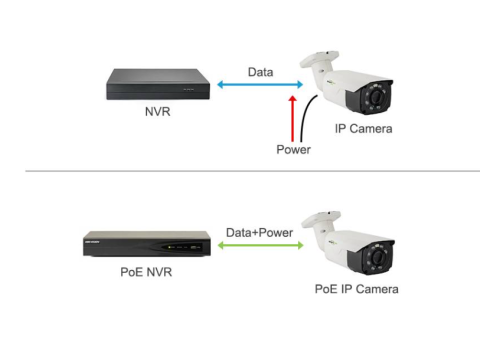POE: WHAT IT IS AND HOW IT WORKS
KEY FEATURES AND PARAMETERS
CAMERAS AND SWITCHES WITH PoE SUPPORT
Power over Ethernet (PoE) is a technology that provides power to IP devices, such as cameras and access points, through the same Ethernet cable used for data transmission.
The term itself, Power over Ethernet, describes the delivery of electricity "over" Ethernet, simplifying setups by eliminating the need for separate power cables or outlets. This makes it a popular choice for:
- IP surveillance cameras
- Wi-Fi access points
- IP phones
- Other compatible devices
PoE STANDARDS
PoE technology has evolved over time, with three key standards currently in use:
- 802.3af (2003): The first standard offers a maximum power output of 15.4 watts per port. It works at speeds of 10/100 Mbps.
- 802.3at (2009): Known as PoE+, this standard increases power output to 30 watts per port, supporting more power-intensive devices.
- 802.3bt (2018): The latest standard, also called PoE++ or 4-pair PoE, delivers up to 90-100 watts per port by utilizing all four pairs of wires in an Ethernet cable.
KEY CHARACTERISTICS
Power Budget:
This is the total power a PoE switch can deliver across all ports. For example, a four-port switch with a 100W budget cannot supply all power to a single port. Each port's individual power capacity should be checked.Transmission Distance:
PoE power can typically be transmitted up to 328 feet (100 meters), depending on cable quality and standard.Backward Compatibility:
Older devices (e.g., those using 802.3af) can still work with newer switches. However, high-powered devices may not be compatible with older standards.Auto-Detection Support:
Modern PoE switches can automatically detect connected devices' power needs, ensuring compatibility and preventing damage to non-PoE devices.
PoE CAMERAS AND SWITCHES
PoE Cameras offer efficient power delivery and data transmission via a single Ethernet cable. They are a favored choice in surveillance for their simplicity and cost-effectiveness in cabling.
Types of PoE Devices:
PoE Injector:
Converts 220V AC power to 40-60V DC for IP cameras and other devices. Typical designs include:- Plug-in adapters directly connected to outlets.
- Units connected via a separate power cable.
Injectors have two ports:
- PoE Port: Connects to the camera.
- LAN Port: Links to the network.
While cost-effective, injectors can only power one camera and do not provide switching capabilities.
PoE Switch:
A switch with integrated PoE injectors for multiple devices. For instance, a typical switch may have:- Four PoE ports for connected devices.
- Two additional LAN ports for local network integration.
Key Considerations for PoE Switches:
- Total power budget.
- Maximum power per port.
PoE switches offer scalability and are ideal for multi-camera setups, unlike standalone injectors or PoE-enabled recorders that require individual cables for each device.
ADVANTAGES OF PoE
- Simplified Installation: A single cable provides both power and data, reducing material costs and installation time.
- Cost Savings: Reduces the need for additional wiring and outlets.
- Remote Reboot Capability: Devices can be restarted without physical interaction.
- Enhanced Safety: Eliminates reliance on external power sources for improved reliability.
- Scalability: Easily expands to support additional cameras or devices.
LIMITATIONS OF PoE
- Higher Costs: Equipment with PoE capability is typically more expensive.
- Power Constraints: The total power available may not suffice for systems requiring high energy, such as outdoor cameras with heaters or PTZ features.
- Infrastructure Requirements: High-power PoE setups may demand upgraded electrical infrastructure.
Despite these limitations, PoE remains the go-to solution for small to medium surveillance systems. For high-demand setups, like outdoor surveillance with additional devices (e.g., IR illuminators or glass defrosters), supplementary power sources may be required.

